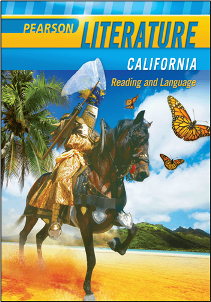Pearson's new Online Essay Scorer powered with WriteToLearn technologies is an important component of the new California Literature program.
WriteToLearn is a complete writing skills and reading comprehension development tool.
WriteToLearn combines the simplicity of Knowledge Technologies' (KT) and the depth of KT's Intelligent Essay Assessor™ into one Web-based product that allows educators to evaluate and teach both writing skills and reading comprehension.
WriteToLearn is based on the KAT™ engine, which uses a proprietary application of the mathematical approach known as Latent Semantic Analysis (LSA). The KAT engine is a unique automated assessment technology for written language that evaluates the meaning of text, not simply grammatical correctness, spelling or other surface elements.
WriteToLearn provides at-a-glance reporting for students and teachers about assignments and progress via easy-to-understand, visually appealing tutorial feedback and status reports. Teachers have flexible scoring options through adjustable passing thresholds and the ability to hide one or more areas of scoring feedback so students can focus on specific areas.
WriteToLearn also offers assignment flexibility thanks to a wide variety of essay prompts and readings to be summarized (identified by subject and grade level) with different scoring options for different classes.
From a single-screen visual scoreboard, teachers can view classes, assignments and progress. And WriteToLearn provides easy drill down to student score detail and writing portfolios.
Click on the following link for a demonstration:
http://www.essayscorer.com/ph/demo
Thursday, March 26, 2009
Friday, March 20, 2009
You think English is easy???
1) The bandage was wound around the wound.
2) The farm was used to produce produce.
3) The dump was so full that it had to refuse more refuse.
4) We must polish the Polish furniture.
5) He could lead if he would get the lead out.
6) The soldier decided to desert his dessert in the desert.
7) Since there is no time like the present, he thought it was time to present the present.
8) A bass head was painted on the head of the bass drum.
9) When shot at, the dove dove into the bushes.
10) I did not object to the object.
11) The insurance was invalid for the invalid.
12) There was a row among the oarsmen about how to row.
13) They were too close to the door to close it.
14) The buck does funny things when the does are present.
15) A seamstress and a sewer fell down into a sewer line.
16) To help with planting, the farmer taught his sow to sow.
17) The wind was too strong to wind the sail.
18) I had to subject the subject to a series of tests.
Let's face it - English is a crazy language. There is no egg in eggplant, nor ham in hamburger; neither apple nor pine in pineapple. Sweetmeats are candies while sweetbreads, which aren't sweet, are meat.
We take English for granted. But if we explore its paradoxes, we find that quicksand can work slowly, boxing rings are square and a guinea pig is neither from Guinea nor is it a pig. And why is it that writers write but fingers don't fing, grocers don't groce and hammers don't ham?
If the plural of tooth is teeth, why isn't the plural of booth, beeth? One goose, two geese. So one moose, two meese?
If teachers taught, why didn't preachers praught? If a vegetarian eats vegetables, what does a humanitarian eat?
How can a slim chance and a fat chance be the same, while a wise man and a wise guy are opposites?
English was invented by people, not computers, and it reflects the creativity of the human race, which, of course, is not a race at all.
2) The farm was used to produce produce.
3) The dump was so full that it had to refuse more refuse.
4) We must polish the Polish furniture.
5) He could lead if he would get the lead out.
6) The soldier decided to desert his dessert in the desert.
7) Since there is no time like the present, he thought it was time to present the present.
8) A bass head was painted on the head of the bass drum.
9) When shot at, the dove dove into the bushes.
10) I did not object to the object.
11) The insurance was invalid for the invalid.
12) There was a row among the oarsmen about how to row.
13) They were too close to the door to close it.
14) The buck does funny things when the does are present.
15) A seamstress and a sewer fell down into a sewer line.
16) To help with planting, the farmer taught his sow to sow.
17) The wind was too strong to wind the sail.
18) I had to subject the subject to a series of tests.
Let's face it - English is a crazy language. There is no egg in eggplant, nor ham in hamburger; neither apple nor pine in pineapple. Sweetmeats are candies while sweetbreads, which aren't sweet, are meat.
We take English for granted. But if we explore its paradoxes, we find that quicksand can work slowly, boxing rings are square and a guinea pig is neither from Guinea nor is it a pig. And why is it that writers write but fingers don't fing, grocers don't groce and hammers don't ham?
If the plural of tooth is teeth, why isn't the plural of booth, beeth? One goose, two geese. So one moose, two meese?
If teachers taught, why didn't preachers praught? If a vegetarian eats vegetables, what does a humanitarian eat?
How can a slim chance and a fat chance be the same, while a wise man and a wise guy are opposites?
English was invented by people, not computers, and it reflects the creativity of the human race, which, of course, is not a race at all.
Labels:
"language arts",
education,
English,
learn,
Learning,
literature,
Pearson,
reading,
teacher
Subscribe to:
Comments (Atom)


